Many rare species exist among the vast expanse of species residing in the United States. Among some of the rarest animals in the United States are creatures that live on land, in the ocean, and throughout the skies. They embody the delicate balance between survival and inevitable extinction in a world increasingly shaped by human influence.
In this article, we will delve into a selection of 12 of the rarest animals you can find in the United States, uncovering the reasons behind their rarity, their current status on the conservation spectrum, and prominent fascinating facts about each unique animal.
12. Kemp’s Ridley (Lepidochelys kempii)
Kemp’s Ridley sea turtle, scientifically known as Lepidochelys kempii, is a rare and critically endangered species that you can find in the United States. It’s not only the rarest species of sea turtle in the world, but it is also the most endangered species of sea turtle. Kemp’s Ridley primarily nests on the beaches of the Gulf of Mexico, particularly in the United States. In the United States, you can find them along the coastal shores of Virginia, Texas, South Carolina, Rhode Island, North Carolina, New Jersey, New Hampshire, Mississippi, Massachusetts, Maryland, Maine, Alabama, Connecticut, Delaware, Florida, Georgia, and Louisiana.
The Kemp’s Ridley sea turtle is rare due to several factors. Their numbers were first affected by egg harvesting. However, they are primarily and presently affected by habitat loss due to coastal development, accidental capture in fishing gear, climate change, and pollution. These turtles have a unique mass nesting behavior known as an “arribada,” which translates to “arrival by sea” in Spanish. This is where hundreds of females come ashore to lay eggs simultaneously. Unfortunately, this synchronized nesting makes them vulnerable to poaching.
On the IUCN Red List, Kemp’s Ridley is classified as critically endangered, the highest level of endangerment. Conservation efforts have been put in place to protect their nesting sites, implement fishing gear modifications to reduce bycatch and raise awareness about the importance of their conservation. As of the last report released by the IUCN Red List on this species, there are approximately 22,340 mature individuals in the wild.

The scientific name of the Kemp’s Ridley sea turtle is
Lepidochelys kempii.
©Cavan Images/iStock via Getty Images
11. Rusty Patched Bumble Bee (Bombus affinis)
The Rusty Patched Bumble Bee is one of the rarest bees in the United States. Worker bees have a distinctive rusty-colored patch on their abdomen. Habitat loss, pesticide use, pollution, climate change, and diseases affecting bee populations influence its rarity.
This bee species was once widespread across the eastern and midwestern regions of the United States, but its population has drastically declined. Over the last 20 years, populations have mainly resided in scattered locations in a few states, including Illinois, Iowa, and Maryland.
On the IUCN Red List, the Rusty Patched Bumble Bee is critically endangered. The decline in its numbers has raised concerns about the loss of pollinators on the whole, which are vital for maintaining biodiversity and crop production.
Conservation efforts for this species and other struggling bee species involve protecting and restoring their native habitats, reducing pesticide use, and monitoring disease outbreaks. Efforts are also being made to raise awareness about the importance of pollinators in maintaining healthy ecosystems.
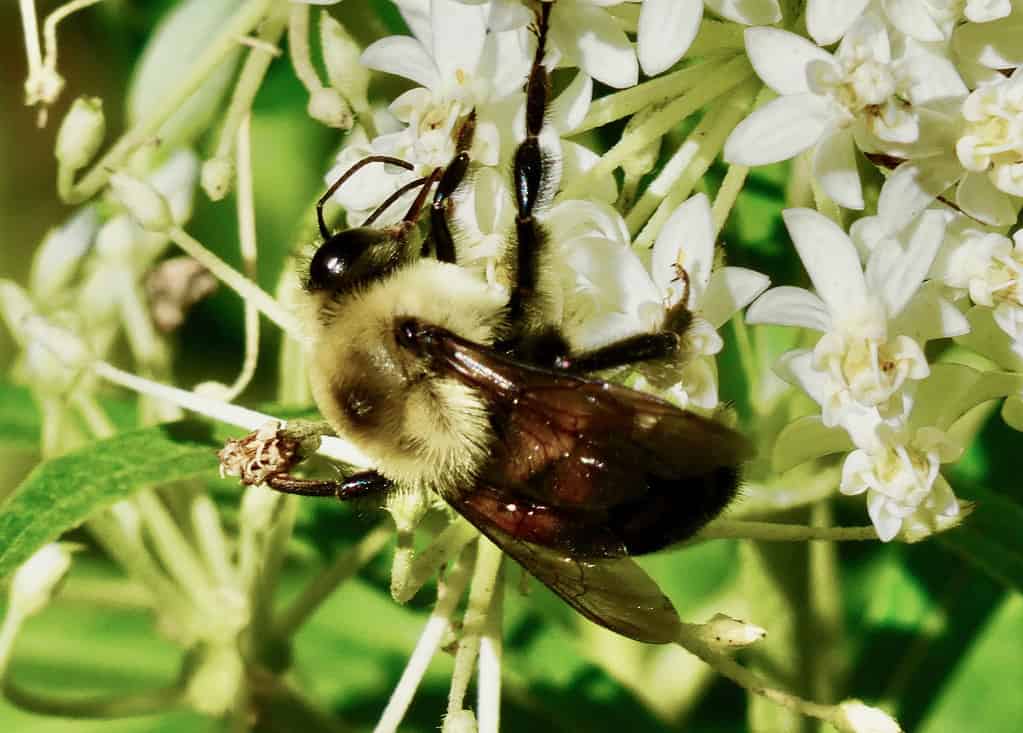
One of the rarest bees in the United States is the Rusty Patched Bumble Bee.
©Lisa Herlick/iStock via Getty Images
10. Akekee (Loxops caeruleirostris)
The Akekee is an exceedingly rare bird species endemic to the Hawaiian Islands. Its rarity is primarily due to habitat loss, climate change, and predation by introduced species. You can only find these small forest birds on the island of Kauai. As of 2018, the IUCN Red List states that populations of mature individuals are estimated to range from 300 to 1,000.
The Akekee’s population has been steadily declining, and it is now considered critically endangered on the IUCN Red List. Habitat destruction, particularly the loss of native forests, has had a significant impact on this species. The introduction of various plants, like the banana pōka, a passionflower vine, has threatened the Akekee due to the displacement of native plants that this bird relies on as its primary food source of specific insects. Furthermore, introduced mosquitoes brought Avian malaria and fowlpox to Kauai. This has dramatically affected Akekee population numbers and has pushed their populations to areas above 1,100 meters above sea level as mosquitoes cannot sustain at those elevations.
Conservation efforts for the Akekee include habitat restoration and invasive species control. Captive breeding and reintroduction programs have also been initiated to bolster the wild population.

The Akekee resides solely on the Hawaiian island of Kauai.
©EdoTealdi/iStock via Getty Images
9. Mojave Desert Tortoise (Gopherus agassizii)
The Mojave Desert Tortoise is a rare and iconic species residing in the southwestern United States. Its native range in the United States is across the Mojave and Sonoran Deserts. There are a myriad of factors compounding to decrease their populations. They include natural predators, habitat destruction, pollution, poaching, disease, and climate change, to name a few.
These tortoises inhabit the arid landscapes of western Arizona, southeastern California, southern Nevada, and southwestern Utah. However, due to habitat degradation caused by urban development, off-road vehicle use, and military activities, their numbers are continuing to decline significantly.
The Mojave Desert Tortoise is listed as threatened on the IUCN Red List. Conservation efforts for this species include establishing protected areas, managing wind and solar farm activity, managing urbanization, and educating the public.

The Mojave
Desert Tortoise
resides in the Mojave and Sonoran Deserts in the United States.
©Paul Dionne/iStock via Getty Images
8. California Condor (Gymnogyps californianus)
The California Condor was once one of the rarest and most critically endangered bird species in the United States. It is also the largest North American land bird. Their rarity is primarily due to habitat destruction, lead poisoning, pollution, hunting, and climate change.
These massive vultures once ranged across the United States. After their extinction from the wild, they were reintroduced to northern Arizona, southern Utah, and the coastal mountains of California. Conservation efforts, including captive breeding programs, have been crucial in their recovery. A fascinating fact about California Condors is their remarkable wingspan, which can exceed 9.8 feet. They are vital to ecosystem health as creatures who feed on carrion. Moreover, these fascinating birds can live up to 60 years.
On the IUCN Red List, the California Condor is listed as critically endangered. In 1987, they went extinct in the wild. Conservation entities have reintroduced them to areas within their native lands. Before 2020, their populations dwindled below 100 individuals. By 2020, populations increased to approximately 500 individuals across the wild and captivity. By 2022, their population had grown to roughly 530 individuals. Thanks to intensive conservation efforts, their populations are continuing to increase. Furthermore, they are continuing to be reintroduced into parts of their historic range. Preserving the California Condor has been a testament to the success of conservation programs and the importance of protecting endangered species.
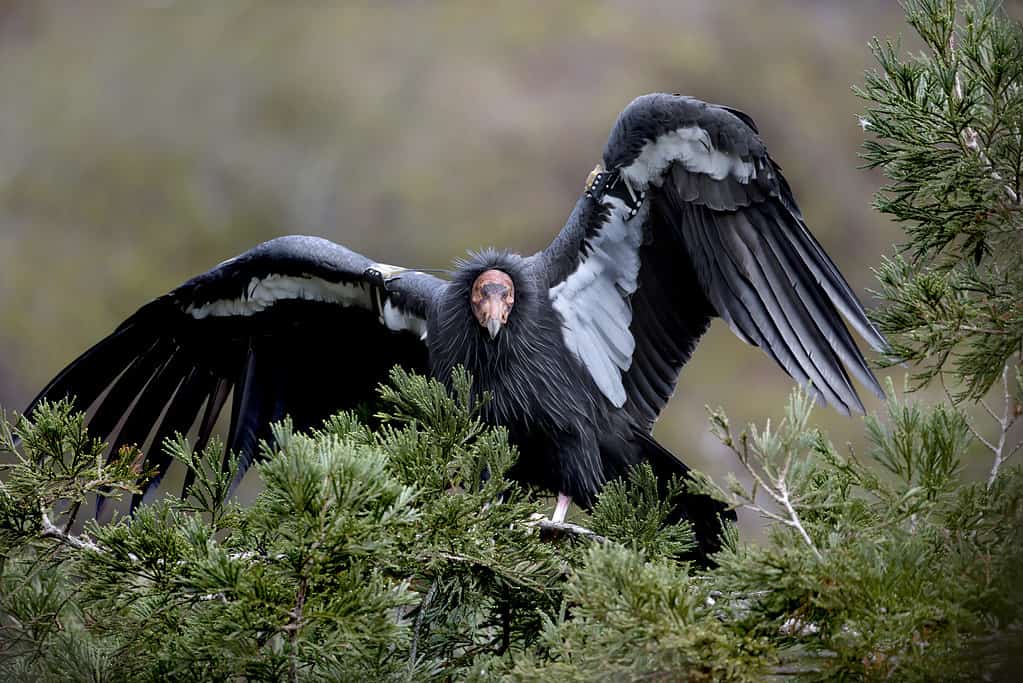
The California Condor was extinct in the wild by 1987. By 2022, their population stand around 530 individuals across the wild and captivity.
©pjsells/iStock via Getty Images
7. North Atlantic Right Whale (Eubalaena glacialis)
The North Atlantic Right Whale is another one of the rarest animals in the United States on our list. This critically endangered marine mammal resides in the waters of the North Atlantic Ocean. They spend their winters calving around the coastal waters of Georgia and Florida. Its rarity is primarily due to historical hunting, ship strikes, pollution, climate change, and entanglement in fishing gear.
These massive whales, known for their thick blubber and lack of a dorsal fin, were once heavily hunted for their valuable blubber, which contained ample whale oil, baleen plates, and later their meat. This exploitation led to a dramatic decline in their population.
On the IUCN Red List, the North Atlantic Right Whale is listed as critically endangered, with an estimated maximum of 250 mature individuals remaining. Conservation efforts include implementing ship speed limits in critical habitats, reducing pollution, and conducting research to understand their behavior and migration patterns better.

The North Atlantic Right Whale is critically endangered.
©6381380/iStock via Getty Images
6. Maui Parrotbill (Pseudonestor xanthophrys)
The Maui Parrotbill is an extremely rare bird species residing exclusively on the Hawaiian island of Maui. With declining populations due to habitat loss, invasive species, and climate change, it is now one of the rarest animals in the United States.
The Maui Parrotbill inhabits the dense rainforests of Maui. One fascinating aspect of the Maui Parrotbill is its specialized beak. They use their large beaks and strong jaws to remove bark and wood from small trees and shrubs, unearthing their primary food source, which is insects. Their population has been declining due to habitat destruction and the introduction of non-native species that crow dour their natural resources and bring non-native diseases.
On the IUCN Red List, the Maui Parrotbill is listed as critically endangered. In 2016, there were approximately 250 to 550 mature individuals in the wild. Most unfortunately, more recent surveys report an estimated population of approximately 150 individuals or less remaining in the wild. Conservation efforts focus on protecting their forest habitats, controlling invasive species, and establishing captive breeding programs.

Today less than 150 individual Maui Parrotbills are remaining in the wild.
©7Michael/iStock via Getty Images
5. Red Wolf (Canis rufus)
The Red Wolf is one of the rarest and most endangered species in the United States. This species is rare due to the consequences of habitat loss, hybridization with coyotes, historical hunting, and lack of protection.
Historically, they were native to the southeastern and south-central United States. In the United States, this range extended from the Atlantic Ocean to central Texas, all the way up to southwestern Illinois, and spanning to southern New York. By the mid-1900s, the Red Wolf’s range significantly decreased. After their population dwindled to less than 20 individuals in the mid-1970s, the remaining individuals were captured to establish a captive-bred population. In the mid-1980s, the captive individuals were released into the Alligator River National Wildlife Refuge (ARNWR) in North Carolina. Since then, wild populations have fluctuated from between 100 to less than 10 individuals. As of 2023, there are approximately 15 individuals in the ARNWR.
On the IUCN Red List, the Red Wolf is rightfully classified as critically endangered. The intriguing aspect of these wolves is their unique status as a species that was declared extinct in the wild in 1980, similar to the California Condor, but subsequently reintroduced from captive populations. Efforts to save the Red Wolf include captive breeding, genetic management to reduce hybridization with coyotes, and increased protection.

You can find remaining Red Wolf populations in the
Alligator
River National Wildlife Refuge (ARNWR) in North Carolina.
©Cavan Images/iStock via Getty Images
4. Alabama Sturgeon (Scaphirhynchus suttkusi)
The Alabama Sturgeon is yet another of the rarest and critically endangered fish species in the United States. This species is rare primarily due to habitat alteration, dams, invasive species, and water pollution, to name a few.
Alabama Sturgeon are yellowish to orangish in color. Moreover, they can live up to 12 to 20 years and grow up to 30 inches in length. These prehistoric-looking sturgeons are native to the Mobile River Basin in Alabama, but their populations have drastically declined. Furthermore, this fish is critically endangered on the IUCN Red List, with approximately 10 or less mature individuals left in the wild. More present-day surveys suggest that you can only find them in the lower 130 miles of the Alabama River.
Conservation efforts for this species include habitat restoration and monitoring their remaining populations. Efforts to save the Alabama Sturgeon are critical not only for preserving their unique evolutionary lineage but also for maintaining the health of the river ecosystems they inhabit.
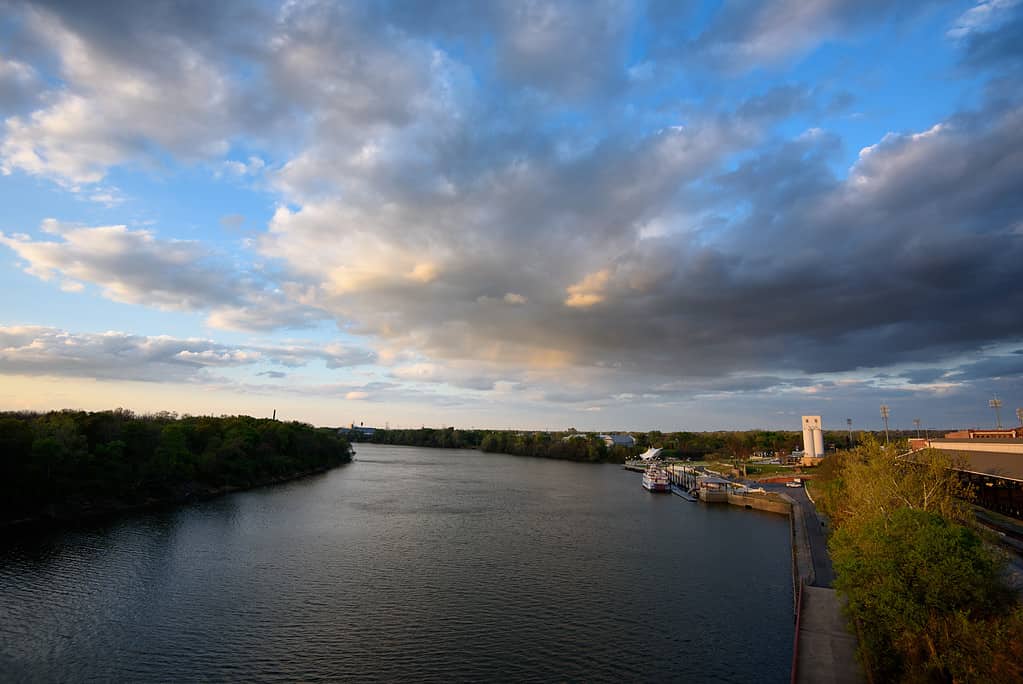
Alabama Sturgeon resides in the lower part of the Alabama River and can live up to 12 to 20 years.
©Sutherland_Boswell/iStock via Getty Images
3. Ivory-billed Woodpecker (Campephilus principalis)
The Ivory-billed Woodpecker is so rare that it might be extinct. Due to habitat loss, climate change, and historical over-exploitation, these iconic birds are a scarce bird species in the United States.
These majestic woodpeckers were once found abundantly in the southeastern United States, and experts thought them to be extinct for decades. However, numerous unconfirmed sightings over the years have fueled hope for their continued existence, though their status remains uncertain. Their impressive size and striking appearance, closely resembling the Imperial Woodpecker (Campephilus imperialis), would make them a sight to behold.
Historically, the Ivory-billed Woodpecker is listed as classified as critically endangered on the IUCN Red List, with populations estimated between 1 to 50 individuals remaining. However, due to limited confirmed sightings, their official status remains a subject of debate among ornithologists. Efforts to search for Ivory-billed Woodpeckers continue. However, it is widely considered a lost species.
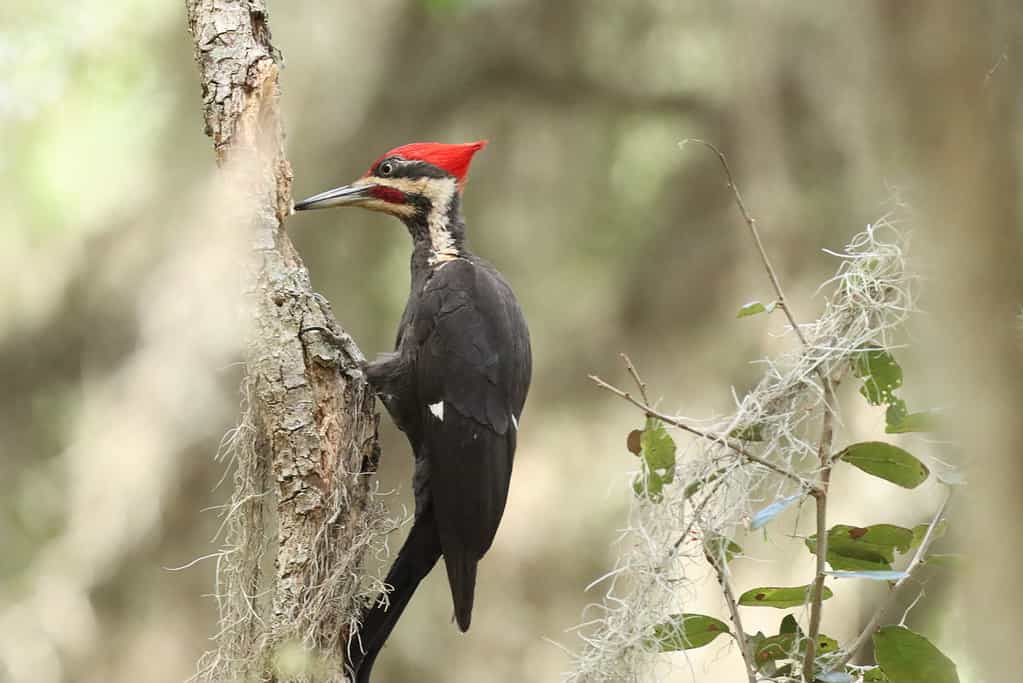
The Ivory-billed Woodpecker is so rare, that experts are unable to confirm whether or not the species is extinct or simply incredibly elusive.
©Wirestock/iStock via Getty Images
2. Bethany Beach Firefly (Photuris bethaniensis)
The Bethany Beach Firefly is an exceptionally rare firefly species you can find in the United States if you’re exceptionally lucky. This species resides solely along one stretch of shoreline near Bethany Beach in Delaware.
Overall, its rarity is primarily due to habitat loss, climate change, light pollution, and urbanization. Their habitat has been threatened by urban development and the introduction of artificial light sources that disrupt their natural behaviors. Furthermore, experts believe rising sea levels to be their biggest threat.
The conservation status of the Bethany Beach Firefly is listed on the IUCN Red List as critically endangered. Local and regional efforts are underway to protect their habitats. However, their remaining populations are declining swiftly and will be extinct by the end of 2023.
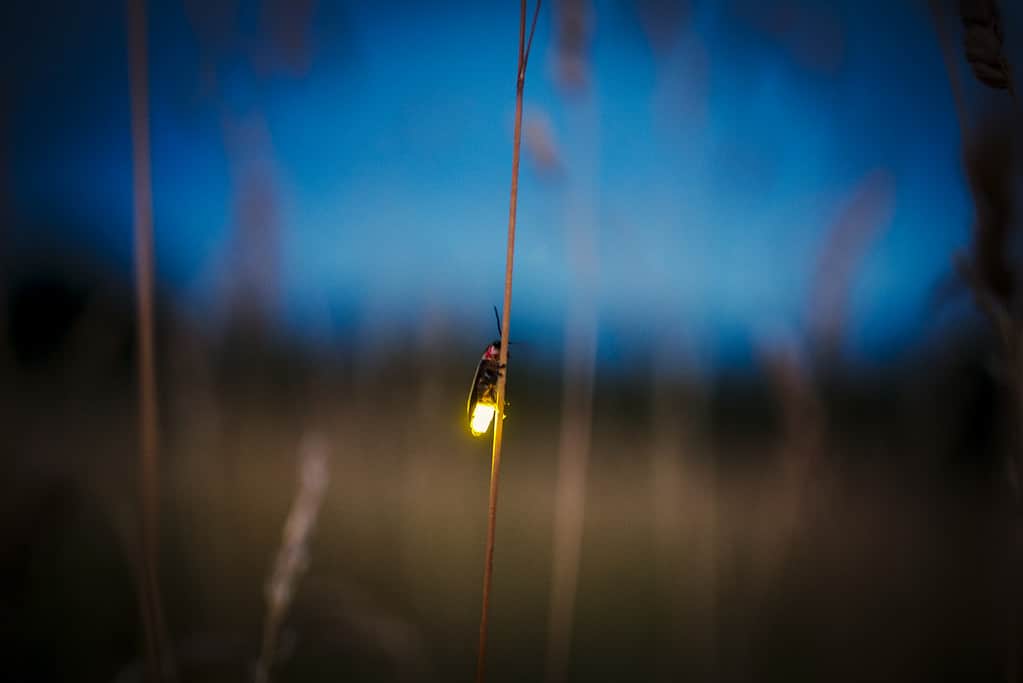
The Bethany Beach Firefly will be extinct within the next year.
©Jeremy_Hogan/iStock via Getty Images
1. ‘Akikiki (Oreomystis bairdi)
The scientific name of the ‘Akikiki is Oreomystis bairdi. It is arguably the rarest bird endemic to the Hawaiian island of Kauai. Similar to the Akekee, it is rare due to habitat loss, introduced diseases, climate change, and invasive species.
You could or can find these tiny, grayish birds with distinctive facial markings in the high-elevation forests of Kauai. The ‘Akikiki’s habitat is severely impacted by deforestation. As a result, its population has dwindled dramatically.
On the IUCN Red List, the ‘Akikiki is classified as critically endangered, with a rapidly declining population. Efforts to save this species include habitat restoration, control of invasive predators, and monitoring for diseases like avian malaria. In 2018, there were approximately 150 to 600 mature individuals left in the wild. By 2020, a survey report estimated that the population declined to roughly 45 individuals. By mid-2023, a survey report assessed the population to stand at around five individuals. Sadly, this species will be extinct in the wild by the end of 2023. Furthermore, this makes it one of the rarest animals to exist in the United States.
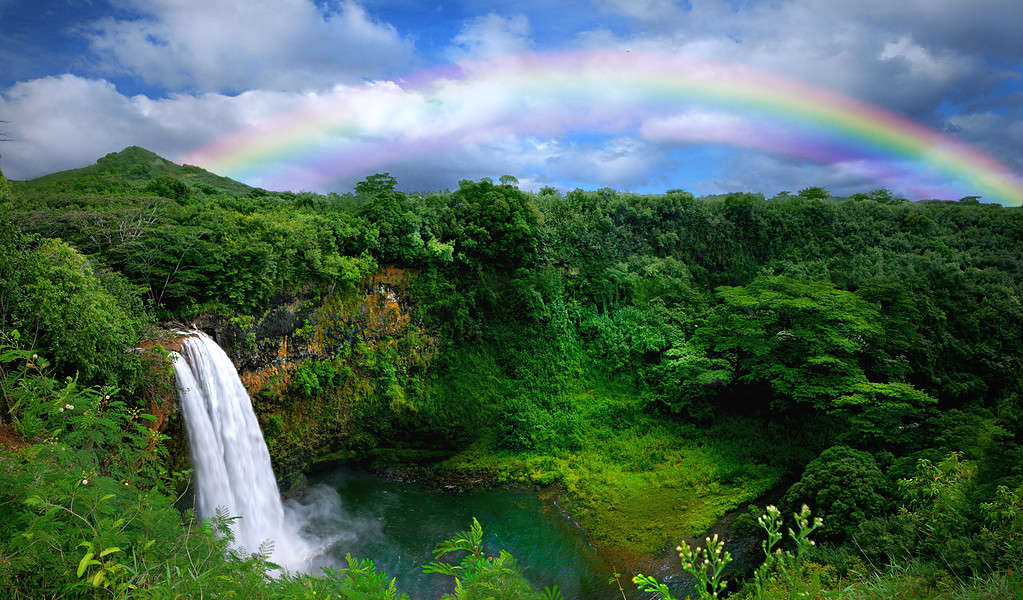
The ‘Akikiki resides solely on the Hawaiian island of Kauai. It is nearly if not recently extinct in the wild.
©Katrina Brown/iStock via Getty Images
List of Some of the Rarest Animals in the United States
| Rank | Species | Scientific Name | Known Locations |
|---|---|---|---|
| 12 | Kemp’s Ridley | Lepidochelys kempii | Coastal Eastern United States and Coastal Gulf of Mexico |
| 11 | Rusty Patched Bumble Bee | Bombus affinis | Primarily Illinois, Iowa, and Maryland |
| 10 | Akekee | Loxops caeruleirostris | Hawaiian Island of Kauai |
| 9 | Mojave Desert Tortoise | Gopherus agassizii | Arizona, California, Nevada, and Utah |
| 8 | California Condor | Gymnogyps californianus | California, Arizona, and Utah |
| 7 | North Atlantic Right Whale | Eubalaena glacialis | Atlantic Coast of the United States (primarily off of Georgia and Florida) |
| 6 | Maui Parrotbill | Pseudonestor xanthophrys | Hawaiian Island of Maui |
| 5 | Red Wolf | Canis rufus | Alligator River National Wildlife Refuge in North Carolina |
| 4 | Alabama Sturgeon | Scaphirhynchus suttkusi | Alabama River in Alabama |
| 3 | Ivory-billed Woodpecker | Campephilus principalis | Louisiana, Florida, and Arkansas |
| 2 | Bethany Beach Firefly | Photuris bethaniensis | Coastal Delaware |
| 1 | ‘Akikiki | Oreomystis bairdi | Hawaiian Island of Kauai |
Conclusion
Some of the rarest animals in the United States are also the most endangered species. They stand as poignant symbols of the ongoing challenges in wildlife conservation. Some species are stable or are seeing an increase in population, while others are near extinction in the wild. Each species faces dangers, some of which include habitat loss, disease, urbanization, invasive species, hunting, pollution, climate change, or other human-induced threats, to name a handful. Yet, some of these species, such as the California Condor, exemplify the resilience of nature and the tireless efforts of conservationists to preserve Earth’s biodiversity.
The critically endangered Red Wolf has experienced an unsteady fluctuation in populations. Yet, this species has been held from the brink of total extinction through dedicated conservation programs. Moreover, the Alabama Sturgeon, a long-lived fish species, reminds us of the importance of safeguarding our aquatic ecosystems and the consequences of not initiating protection swiftly enough.
In the avian world, the elusive Ivory-billed Woodpecker captivates our imaginations with its elusive yet uncertain existence and the enduring hope for its confirmed rediscovery. Finally, the tiny Bethany Beach Firefly highlights the reality many species have and will face. They face certain extinction. Similarly, the ‘Akikiki will be completely extinct in the wild by the end of 2023, though captive populations presently stand around 40 individuals.
These rare animals collectively underscore the need for proactive conservation measures, habitat restoration, and public awareness. Furthermore, their stories are a call to action, a reminder that every effort to protect and preserve our planet’s biodiversity is an investment in the future of our natural heritage.
The photo featured at the top of this post is © Cavan Images/iStock via Getty Images
Thank you for reading! Have some feedback for us? Contact the AZ Animals editorial team.







